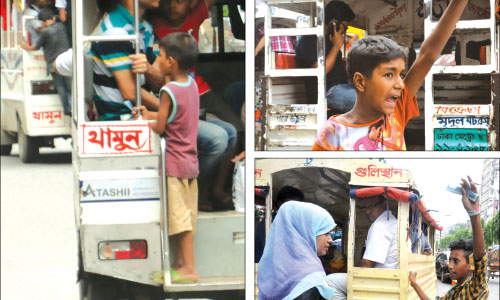8 out of 10 children in hazardous work do not attend schools
Eight out of ten children employed in hazardous work do not attend schools although the National Plan of Action stipulates providing education to working children to transition them out of child labour.
The latest Child Labour Survey of Bangladesh Bureau of Statistics also states seven out of ten child labourers do not attend schools, a lamentable statistic on the occasion of the World Day Against Child Labour, today.
Child rights activists attributed poverty, lack of awareness of guardians, as well as lack of initiatives from the government to create facilities for keeping these child labourers in schools, for the situation.
Education rights activist and Campaign for Popular Education executive director Rasheda K Choudhury and child rights activists and Bangladesh Shishu Adhikar Forum director Abdus Shahid Mahmood said that it was really alarming that so many child labourers did not attend schools.
State Minister of labour and employment Mujibul Haque admitted that many of the child labourers were not attending schools.
‘We have completed a project in which 60,000 children were brought out from hazardous forms of child labour through non-formal education and skill development training in the last four years’.
‘We are now taking up another plan to take out another 50,000 children from hazardous forms of child labour,’ he added.
The Child Labour Survey 2013 that came out in January this year found that 29 per cent child labourers were currently attending schools while 19 per cent child labourers engaged in hazardous work were attending school.
It said that 31 per cent of child labourers in hazardous work and 26 per cent child labourers in general could not attend school owing to the expense. The survey added that 39 per cent children in hazardous work and 29 per cent child labourers could not go to school in order to contribute to the family income.
The survey said that there are 1.7 million child labourers and 1.2 million child labourers in hazardous forms of work.
The National Child Labour Elimination Policy 2010 set a goal to withdraw all forms of child labour work by 2015, and stipulated that as education and recreation is a fundamental right of children, irrespective of the nature of work performed by a child, the employer or owner must ensure adequate educational and recreational facilities after the stipulated working hour.
Financial constraints and a lack of awareness lead many low-income parents to view education as an unfruitful activity. They choose instead the immediate economic benefits of sending their children to work, said Rasheda K Choudhury.
Abdus Shahid Mahmood said children working in subcontracting garment factories, hotels and restaurants, domestic work, bidi factories, wielding workshops and the transport sector cannot attend schools.
Abdus Shahid and Rasheda both emphasized the need for relevant ministries, especially labour and employment, education, primary and mass education, women and child affairs, to coordinate efforts, for ensuring schooling of child labourers and withdrawing them from the workplace.
The government has already missed its deadline on abolishing all forms of child labour from Bangladesh by 2015, set by the National Child Labour Elimination Policy, and is also set to miss the deadline on elimination of hazardous child labour by 2016 set by the National Plan of Action.
Mujibul Haque admitting failure said the country will be free from all kinds child labour by the year 2021.
The government is putting emphasis on technical education and vocational guidance to eliminate all kinds of risky work for children by 2021, he said.
We are coordination with other ministries to achieve the goal, he added.
News Courtesy: www.newagebd.net











